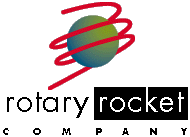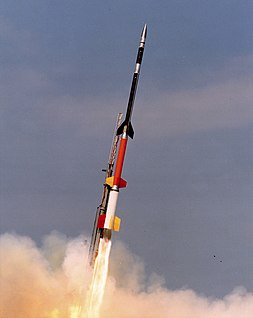
A nuclear thermal rocket is a proposed spacecraft propulsion technology. In a nuclear thermal rocket a working fluid, usually liquid hydrogen, is heated to a high temperature in a nuclear reactor, and then expands through a rocket nozzle to create thrust. In this kind of thermal rocket the nuclear reactor's energy replaces the chemical energy of the propellant's reactive chemicals in a chemical rocket. The thermal heater / inert propellant paradigm as opposed to the reactive propellants of chemical rockets turns out to produce a superior effective exhaust velocity, and therefore a superior propulsive efficiency, with specific impulses on the order of twice that of chemical engines. The overall gross lift-off mass of a nuclear rocket is about half that of a chemical rocket, and hence when used as an upper stage it roughly doubles or triples the payload carried to orbit.

The SM-65 Atlas was the first operational intercontinental ballistic missile (ICBM) developed by the United States and the first member of the Atlas rocket family. It was built for the U.S. Air Force by Convair Division of General Dynamics at the Kearny Mesa assembly plant north of San Diego. Atlas became operational as an ICBM in October 1959 and was used as a first stage for satellite launch vehicles for half a century. The Atlas missile's warhead was over 100 times more powerful than the bomb dropped over Nagasaki in 1945.

A reusable launch system is a space launch system intended to allow for recovery of all or part of the system for later reuse. To date, several fully reusable sub-orbital systems and partially reusable orbital systems have been flown. However the design issues are extremely challenging and no fully reusable orbital launch system has yet been demonstrated. A wide variety of system concepts have been proposed, and several are represented in those which have actually flown.

Gemini 5 was a 1965 manned spaceflight in NASA's Project Gemini. It was the third manned Gemini flight, the eleventh manned American spaceflight, and the nineteenth human spaceflight of all time. It was also the first time an American manned space mission held the world record for duration, set on August 26, 1965, by breaking the Soviet Union's previous record set by Vostok 5 in 1963.

Gemini 1 was the first mission in NASA's Gemini program. An uncrewed test flight of the Gemini spacecraft, its main objectives were to test the structural integrity of the new spacecraft and modified Titan II launch vehicle. It was also the first test of the new tracking and communication systems for the Gemini program and provided training for the ground support crews for the first manned missions.

AS-201, flown February 26, 1966, was the first unmanned test flight of an entire production Block I Apollo command and service module and the Saturn IB launch vehicle. The spacecraft consisted of the second Block I command module and the first Block I service module. The suborbital flight was a partially successful demonstration of the service propulsion system and the reaction control systems of both modules, and successfully demonstrated the capability of the command module's heat shield to survive re-entry from low Earth orbit.

Rotary Rocket Company was a rocketry company that developed the Roton concept in the late 1990s as a fully reusable single-stage-to-orbit (SSTO) manned spacecraft. The design was initially conceived by Gary Hudson, who formed the company to commercialize the concept. The Roton was intended to reduce costs of launching payloads into low earth orbit by a factor of ten.

A spaceplane is an aerospace vehicle that operates as an aircraft in Earth's atmosphere, as well as a spacecraft when it is in space. It combines features of an aircraft and a spacecraft, which can be thought of as an aircraft that can endure and maneuver in the vacuum of space or likewise a spacecraft that can fly like an airplane. Typically, it takes the form of a spacecraft equipped with wings, although lifting bodies have been designed and tested as well. The propulsion to reach space may be purely rocket based or may use the assistance of airbreathing jet engines. The spaceflight is then followed by an unpowered glide return to landing.

The Bristol Bloodhound is a British surface-to-air missile developed during the 1950s. It served as the UK's main air defence weapon into the 1990s and was in large-scale service with the Royal Air Force (RAF) and the forces of four other countries.
The N1 was a super heavy-lift launch vehicle intended to deliver payloads beyond low Earth orbit, acting as the Soviet counterpart to the US Saturn V. It was designed with manned extra-orbital travel in mind. Development work started on the N1 in 1959. Its first stage is the most powerful rocket stage ever built.

A jet pack, rocket belt, or rocket pack is a device worn on the back which uses jets of gas or liquid to propel the wearer through the air. The concept has been present in science fiction for almost a century and became widespread in the 1960s. Real jet packs have been developed using a variety of mechanisms, but their uses are much more limited than their fictional counterparts because of the challenges of Earth's atmosphere, gravity, low energy density of available fuels, and the human body not being suited to fly, and they are principally used for stunts. A practical use for the jet pack has been in extra-vehicular activities for astronauts.
The Multi-Unit Space Transport And Recovery Device or MUSTARD, usually written as Mustard, was a concept explored by the British Aircraft Corporation (BAC) during the mid-1960s for launching payloads weighing as much as 2,300 kg (5,000 lb) into orbit. Operating as a multi-stage rocket for launch, the individual stages were near-identical modules, each flying back to land as a spaceplane.
The Aggregat series was a set of ballistic missile designs developed in 1933–45 by a research program of Nazi Germany's army (Wehrmacht). Its greatest success was the A4, more commonly known as the V-2.

The Paresev was an experimental NASA glider aircraft based upon the kite-parachute studies by NASA engineer Francis Rogallo.

A boilerplate spacecraft, also known as a mass simulator, is a nonfunctional craft or payload that is used to test various configurations and basic size, load, and handling characteristics of rocket launch vehicles. It is far less expensive to build multiple, full-scale, non-functional boilerplate spacecraft than it is to develop the full system. In this way, boilerplate spacecraft allow components and aspects of cutting-edge aerospace projects to be tested while detailed contracts for the final project are being negotiated. These tests may be used to develop procedures for mating a spacecraft to its launch vehicle, emergency access and egress, maintenance support activities, and various transportation processes.

The Hermes project was started in response to Germany's rocket attacks in Europe. Project Hermes was to determine the missile needs of army field forces. "Accordingly the Ordnance Department entered into a research and development contract with the General Electric Company on 20 November 1944. "This contract authorized the General Electric Company to seek the development of long-range missiles that could be used against both ground targets and high-altitude aircraft. The contractor agreed to perform investigations, research, experiments, design, development, and engineering work in connection with the development of long-range missiles for use against ground targets and high-altitude aircraft." General Electric was also to investigate ramjets, solid rocket motors, liquid propellant rocket engines, and hybrid propellants. "The contract also required the General Electric Company to develop remote control equipment, ground equipment, fire control devices, and homing devices."

A glider is a heavier-than-air aircraft that is supported in flight by the dynamic reaction of the air against its lifting surfaces, and whose free flight does not depend on an engine. Most gliders do not have an engine, although motor-gliders have small engines for extending their flight when necessary by sustaining the altitude with some being powerful enough to take off self-launch.

The Redstone Test Stand or Interim Test Stand was used to develop and test fire the Redstone missile, Jupiter-C sounding rocket, Juno I launch vehicle and Mercury-Redstone launch vehicle. It was declared an Alabama Historic Civil Engineering Landmark in 1979 and a National Historic Landmark in 1985. It is located at NASA's George C. Marshall Space Flight Center (MSFC) in Huntsville, Alabama on the Redstone Arsenal, designated Building 4665. The Redstone missile was the first missile to detonate a nuclear weapon. Jupiter-C launched to test components for the Jupiter missile. Juno I put the first American satellite Explorer 1 into orbit. Mercury Redstone carried the first American astronaut Alan Shepard into space. The Redstone earned the name "Old Reliable" because of this facility and the improvements it made possible.
The Mercury-Redstone Launch Vehicle, designed for NASA's Project Mercury, was the first American manned space booster. It was used for six sub-orbital Mercury flights from 1960–61; culminating with the launch of the first, and 11 weeks later, the second American in space. The fourth subsequent Mercury human spaceflights used the more powerful Atlas booster to enter low Earth orbit.
Advanced Gemini is a number of proposals that would have extended the Gemini program by the addition of various missions, including manned low Earth orbit, circumlunar and lunar landing missions. Gemini was the second manned spaceflight program operated by NASA, and consisted of a two-seat spacecraft capable of maneuvering in orbit, docking with unmanned spacecraft such as Agena Target Vehicles, and allowing the crew to perform tethered extra-vehicular activities.


















